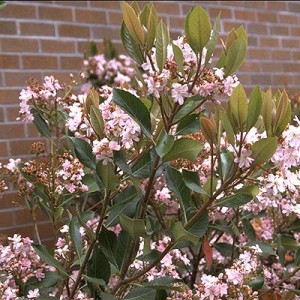Small Patio Trees
 Question from Margo:
Question from Margo:
I am having two trees removed and need replacements. One, will be in an elevated triangular planter about 6″ at the widest point. It is directly over a spa. So I need a tree that will not drop leaves and will not have invasive roots. The second was in the ground and I’m thinking about pouring concrete and using a large container for a tree.
Answer from Pat:
Small trees that will grow in a small raised bed or very large tub and are non-drippy are few and far between. Also you do not inform me of where you live, or what climate zone you live in. If you live in Southern California or in the Bay Area (San Francisco and environs) my top suggestion for a small clean patio tree is Rhaphiolepis ‘Magestic Beauty’. This is a trouble-free tree that is subject to virtually no pests or disease. It’s thought to be a cross between Raphiolepis indica and Eriobotrya, but I think it is just a chance seedling of rhaphiolepis, since I had something similar come up in my own garden from a seed. Leaves and flowers are bigger than the other selections and growth habit is taller and more treelike. It grows well anywhere in the largely populated areas of California from San Francisco on down. It is a clean non-drippy tree, good on streets and good in patios. Shear after bloom once a year to keep in shape. Never prune in autumn or winter or there will be no spring flowers!
Fill the raised bed with good quality top soil (Not potting mix!) and add organic fertilizer also measuring the correct amount. But plant the tree in the pot in potting soil (not top soil!) the best quality you can find. Add some organic fertilizer at planting time that is appropriate for trees. Ask your local nursery to order the tree from Monrovia Nurseries or go to a tree farm to get it. They have specimens with various trunk heights. I would be careful to get one with the tallest trunk available. The small ones take a long time to grow taller, if ever. Ask for one with a good pink color but if you think the pink is a bit washed out looking in spring, don’t worry. The color will deepen as the tree ages, which is good. (The deeper pink color of the flowers is preferable.)
The main trick with pruning rhaphiolepis is to follow this rule: “Prune after bloom, never before bloom!” After spring bloom is done, shear off the top of the plant in June every year in the shape of an umbrella, removing all fruits that form after flowers fade and some foliage. Above is a photograph I took of a mature one in bloom that is pruned correctly in June every year. It is about 25 years old. Best in full sun but can survive in half-shade inland.
It is far better to have two of the same thing than two different plants, but if you want another choice I suggest Agnes Galt pink Chinese hibiscus (Hibiscus rosa-sinensis ‘Agnes Galt’) grown on a trunk as a tree, but this may be difficult to find. Another variety that can be grown on a trunk is ‘Angel Wing’. It has big white flowers. These two will survive many years as trees in containers or small raised beds or streetside and also and are clean trees. Prune as my book suggests for hibiscus starting in March. Keep head in umbrella shape. Fertilize through summer. Cover soil mix with dry bagged earthworm castings against giant white flies if they ever attack this tree, but beneficial insects released by the Department of Agriculture are controlling the giant white flies pretty well. Grow in full sun.

